Synergistic Effects of Multiple Monsoon Systems on Autumn Precipitation in West China
Abstract
1. Introduction
2. Materials and Methods
2.1. Data
2.2. Methods
2.2.1. EASMI
2.2.2. SASMI
2.2.3. AZCI
2.2.4. QTPMI
2.2.5. Monsoon Anomaly Years
2.2.6. Empirical Orthogonal Function (EOF)
3. Results
3.1. Correlation Between Monsoon Indices and WCAP
3.1.1. Basic Characteristics of WCAP
3.1.2. Correlation Analysis of Monsoon Indices and WCAP
3.2. Effects of Different Monsoon Configurations on WCAP
3.2.1. Characterization of Physical Quantity Fields and Precipitation Under Different Configurations of EASM and SASM
3.2.2. Characterization of Physical Quantity Fields and Precipitation Under Different Configurations of AZC and QTPM
3.3. CMIP6 Model Predictions of Future Monsoons and WCAP
4. Discussion and Conclusions
- (1)
- Each monsoon system exhibits different effects on WCAP. The EASM affects WCAP through a closed high-pressure system over Northeast China, resulting in a negative correlation. The influence of the SASM on WCAP is reflected in a pressure gradient that forms over West China, which is located between two closed high-pressure systems; the north side of the strong high-pressure area guides anomalous northwestern transport of cold air, whereas the strong WPSH is guided by the transport of warm and humid air to West China. The resulting convergence of cold and warm air is conducive to the formation of precipitation. During strong AZC years, West China is under the control of a sinking airflow anomaly, which is not conducive to the generation of WCAP. During strong QTPM years, the western and southern parts of West China are affected by sinking airflow from the plateau, resulting in low precipitation.
- (2)
- Owing to the different circulation conditions, water vapor transport, and strong uplift in years with different monsoon configurations, years with a weak EASM and weak SASM or with a weak EASM and strong SASM are more conducive to the generation of WCAP. The wider range of the positive precipitation level may be predominantly related to the negative correlation between the EASM and the majority of WCAP regions. Furthermore, the QTPM is negatively correlated with WCAP in the south and west, whereas the AZC predominantly affects WCAP through dynamic conditions.
- (3)
- According to simulations of future monsoon indices and precipitation using the CMIP6 model, both WCAP and the amplitude of interannual precipitation oscillations will increase under the SSP5-8.5 scenario, along with clear changes in the trends of the EASM, SASM, AZC, and QTPM.
Author Contributions
Funding
Institutional Review Board Statement
Informed Consent Statement
Data Availability Statement
Acknowledgments
Conflicts of Interest
Abbreviations
| EASM | East Asian Monsoon |
| SASM | South Asian Monsoon |
| EASM | Asia Zonal Circulation |
| QTPM | Tibetan Plateau Monsoon |
| WCAP | autumn precipitation in West China |
| WPSH | western Pacific subtropical high |
| WAJ | westerly jet stream |
| TPSM | Tibetan Plateau summer monsoon |
References
- Du, Y.; Wang, Z. A study of rainy seasons in China. Meteorol. Atmos. Phys. 2008, 100, 121–138. (In Chinese) [Google Scholar] [CrossRef]
- Bai, H.Z.; Dong, W.J. Climatic characteristics and causes of autumn rains in western China. Highl. Meteorol. 2004, 6, 884–889. (In Chinese) [Google Scholar]
- Yuan, X. Temporal and Spatial Characteristics of Fall Rains and Their Interannual Variations in Western China. Master’s Thesis, Nanjing University of Information Engineering, Nanjing, China, 2013. (In Chinese). [Google Scholar]
- Sun, Z.X.; Yang, X.B.; Ma, Z.F. Monitoring Index and Causes of Autumn Rains over Southwest China in Recent 50 years. Meteorol. Sci. Technol. 2013, 41, 883–888. [Google Scholar]
- Li, Y.N. Evolution Characteristics of Autumn Rain in Western China and Its Synergistic Mechanism of Upper and Lower Atmospheric Circulation. Master’s Thesis, Chinese Academy of Meteorological Sciences, Beijing, China, 2024. (In Chinese). [Google Scholar]
- Huang, R.H.; Zhang, Z.Z.; Huang, G. Characteristics of the water vapor transport in East Asian monsoon region and its difference from that in South Asian monsoon region in summer. Sci. Atmos. Sin. 1998, 22, 460–469. (In Chinese) [Google Scholar]
- Hao, L.S.; Ding, Y.H.; Min, J.Z. Relationship between summer monsoon changes in East Asia and abnormal summer rainfall in North China. Plateau Meteor. 2016, 35, 1280–1289. [Google Scholar]
- Huan, Y.; Li, Y.Q. The synergy between the East Asian summer monsoon and the South Asian summer monsoon and its relations with anomalous rainfall in Southern China. Plateau Meteor. 2018, 37, 1563–1577. [Google Scholar]
- Liu, Y.Y. Remote Correlation of the Asia-Pacific Summer Winds and Its Effect on Summer Precipitation in China. Ph.D. Thesis, Chinese Academy of Meteorological Sciences, Beijing, China, 2009. (In Chinese). [Google Scholar]
- Wang, Y.S.; Xiao, T.G.; Dong, X.F.; Li, Y.; Zhao, P. Influence of East Asian monsoon and South Asian monsoon synergy on summer precipitation in Southwest China. Acta Meteorol. Sin. 2021, 79, 541–557. (In Chinese) [Google Scholar]
- Feng, L.L.; Hua, W. Effects of westerly monsoon synergism on late spring-May precipitation in Yunnan. Highl. Mt. Meteorol. Res. 2022, 42, 42–48. (In Chinese) [Google Scholar]
- Yan, H.S.; Hu, J.; Fan, K. Relationship between the change of summer westerly wind index and summer precipitation in China over the past 50 years. Atmos. Sci. 2007, 4, 717–726. (In Chinese) [Google Scholar]
- Deng, H.; Hua, W.; Ming, J.; Zhang, Y.; Fan, G.Z. Reversal of decadal trend in West China autumn rainfall in the late 1990s and possible causes. Atmos. Res. 2023, 294, 106984. [Google Scholar] [CrossRef]
- Luo, X.; Li, D.L.; Wang, H. New features of the evolution of fall rains in western China and their response to atmospheric circulation. Plateau Meteorol. 2013, 32, 1019–1031. (In Chinese) [Google Scholar]
- Qiao, Y.T.; Chen, L.T.; Zhang, Q.Y. Definition of the East Asian Monsoon Index and its relation to the climate of China. Atmos. Sci. 2002, 26, 69–82. (In Chinese) [Google Scholar]
- Ma, M.M. Influence of the BSISO and Tibetan Plateau Summer Monsoon on Precipitation in Southwest China. Master’s Thesis, The Lanzhou University, Lanzhou, China, 2022. (In Chinese). [Google Scholar]
- Liu, F.; He, J.H.; Jiang, A.J. Relationship between the Asian summer westerly wind index and summer precipitation in China. J. Nanjing Meteorol. Inst. 2006, 4, 517–525. (In Chinese) [Google Scholar]
- Xu, M.L.; Zhou, B.T.; Cheng, Z.G. A preliminary study on the causes of the inter-decadal increase of fall precipitation in West China since 2010. J. Atmos. Sci. 2020, 43, 568–576. (In Chinese) [Google Scholar]
- Zhou, B.T.; Qian, J.; Hu, Y.P.; Li, H.; Han, T.T.; Sun, B. Interdecadal change in the linkage of early summer sea ice in the Barents Sea to the variability of West China Autumn Rain. Atmospheric 2023, 287, 106717. [Google Scholar] [CrossRef]
- Zhang, H.; Fan, K. Intraseasonal northward evolution of the extreme autumn rainfall event in West China in 2021. Atmospheric 2024, 304, 107394. [Google Scholar] [CrossRef]
- Sun, X.R.; Chen, L.X.; He, J.H. Sea-land thermal difference index in East Asia and its relationship with interannual variability of circulation and precipitation. J. Meteorol. 2002, 2, 164–172. (In Chinese) [Google Scholar]
- Zhang, T.; Jiang, X.; Yang, S. A predictable prospect of the South Asian summer monsoon. Nat. Commun. 2022, 13, 7080. [Google Scholar] [CrossRef]
- Chen, H.S.; Sun, Z.B. An index reflecting winter temperature anomalies in China-East Asian regional westerly wind index. J. Nanjing Meteorol. Inst. 2001, 4, 458–466. (In Chinese) [Google Scholar]
- Qi, D.M. Analysis of the Relationship Between High Pressure Activities in South Asia and the Evolution of the Plateau Monsoon. Master’s Thesis, Chinese Academy of Meteorological Sciences, Beijing, China, 2008. (In Chinese). [Google Scholar]
- Zhou, Y.; Fan, G.Z.; Hua, W. Distribution characteristics of the plateau monsoon and comparative analysis of its indices. Plateau Meteorol. 2015, 34, 1517–1530. (In Chinese) [Google Scholar]
- Huang, Y.X.; Li, D.L.; Wang, B.J.; He, J.M. Analyese on Temporal-Spatial Features of Annual Precipitation in Northwest China in 1961–2000. Plateau Meteorol. 2004, 12, 245–252. (In Chinese) [Google Scholar]
- Huang, R.H.; Chen, J.L.; Huang, G.; Zhang, Q.L. Quasi-Biennial Oscillation of Summer Monsoon Rainfall in China and Its Cause. Chin. J. Atmos. Sci. 2006, 4, 545–560. (In Chinese) [Google Scholar]
- Xia, Z.M.; Liao, K.T.; Guo, L.P.; Chen, X.L. Spatiotemporal Distribution Pattern of Precipitation in Ganjiang River Basin Based on EOF and MK trend Analysis. Res. Soil Water Conserv. 2023, 30, 223–233+249. [Google Scholar]
- Wang, J.K.; Yu, J.Y.; Johnson, K.R. Pacific and Atlantic controls of the relationship between Mainland Southeast Asia and East China interannual precipitation variability. Clim. Dyn. 2020, 54, 4279–4292. [Google Scholar] [CrossRef]
- Chen, X.; Wang, S.; Hu, Z.; Zhou, Q.; Hu, Q. Spatiotemporal characteristics of seasonal precipitation and their relationships with ENSO in Central Asia during 1901–2013. J. Geogr. Sci. 2018, 28, 1341–1368. [Google Scholar] [CrossRef]
- Liang, J.H. Temporal and spatial distribution of fall rains in western China. Geoscience 1989, 1, 51–59+96. (In Chinese) [Google Scholar]
- Xu, J.X.; Guo, H.Y.; Wang, Q. Spatial typing and its characterization of autumn rain in West China. Highl. Mt. Weather. Res. 2019, 39, 26–33. (In Chinese) [Google Scholar]
- Tian, J.; Zhang, Z.; Ahmed, Z. Projections of precipitation over China based on CMIP6 models. Stoch. Environ. Res. Risk Assess. 2021, 35, 831–848. [Google Scholar] [CrossRef]
- Yang, X.; Zhou, B.; Xu, Y. CMIP6 Evaluation and Projection of Temperature and Precipitation over China. Adv. Atmos. Sci. 2021, 38, 817–830. [Google Scholar] [CrossRef]
- Lu, K.; Arshad, M.; Ma, X.; Ullah, I.; Wang, J.; Shao, W. Evaluating observed and future spatiotemporal changes in precipitation and temperature across China based on CMIP6-GCMs. Int. J. Climatol. 2022, 42, 7703–7729. [Google Scholar] [CrossRef]
- Chen, M.F.; Han, Y.G.; Sun, M.D. Prediction and analysis of future precipitation changes in the Sichuan section of the Yangtze River Basin based on the CMIP6 climate model. Res. Soil Water Conserv. 2024, 31, 288–294. (In Chinese) [Google Scholar]

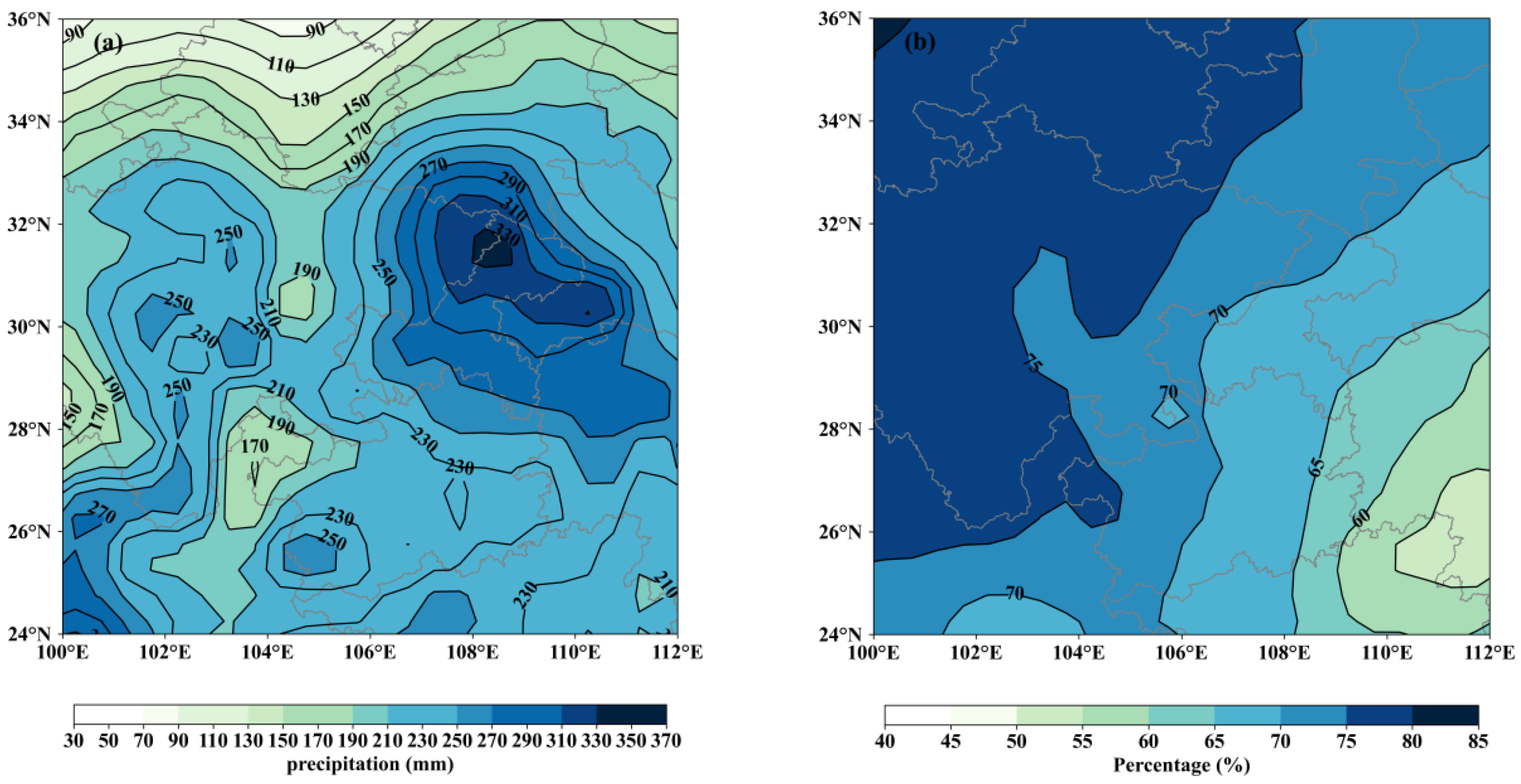
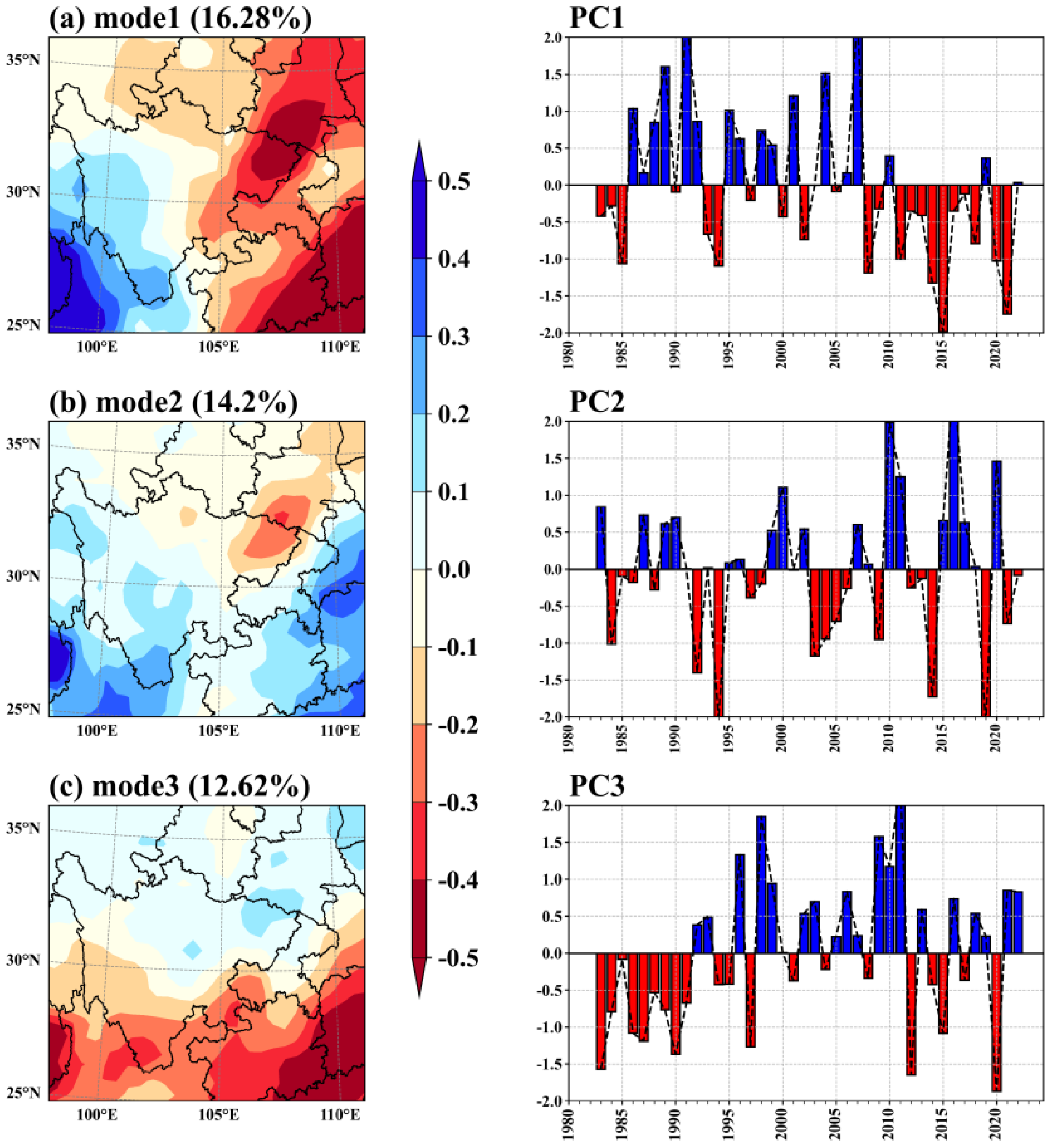
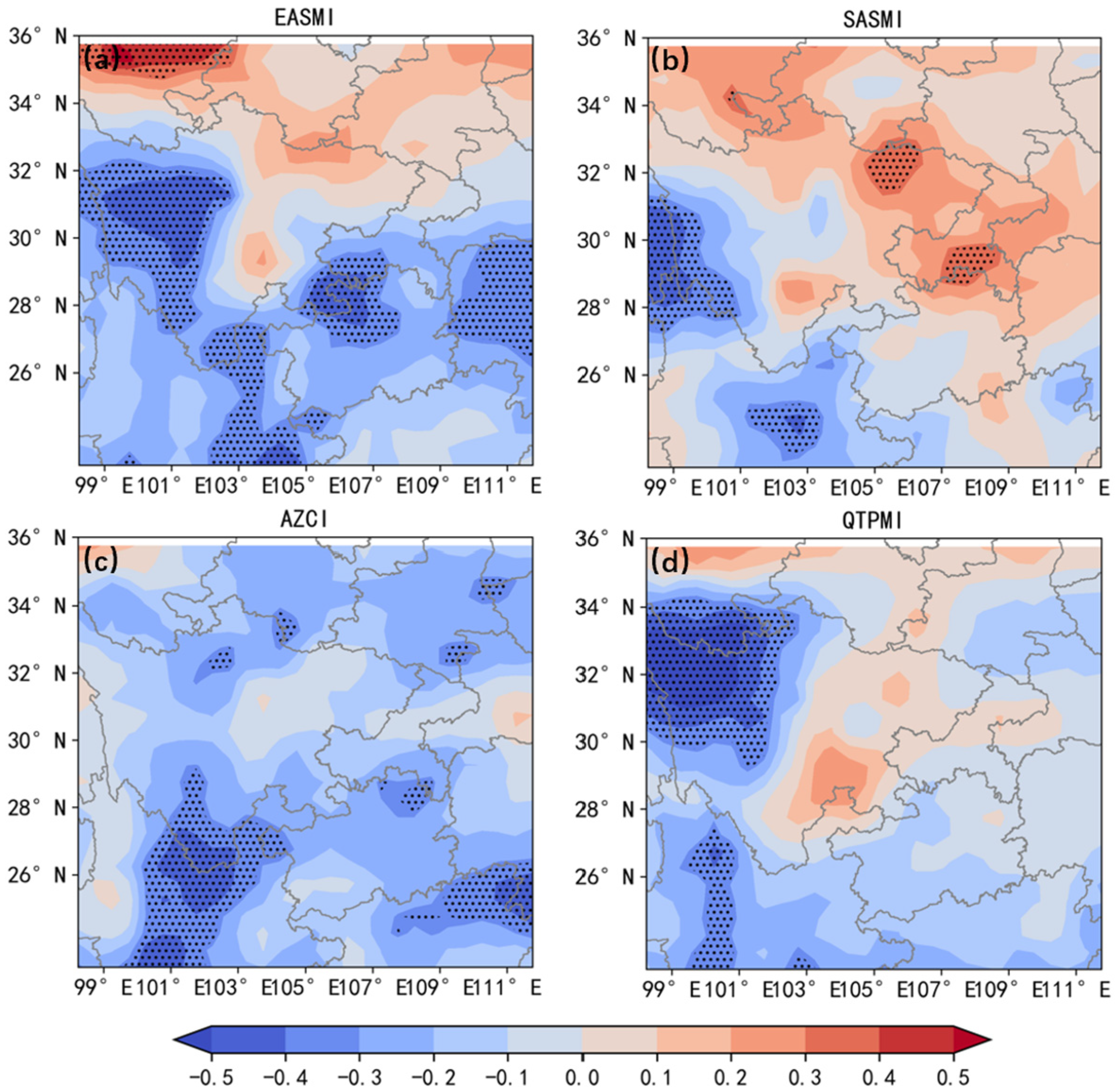
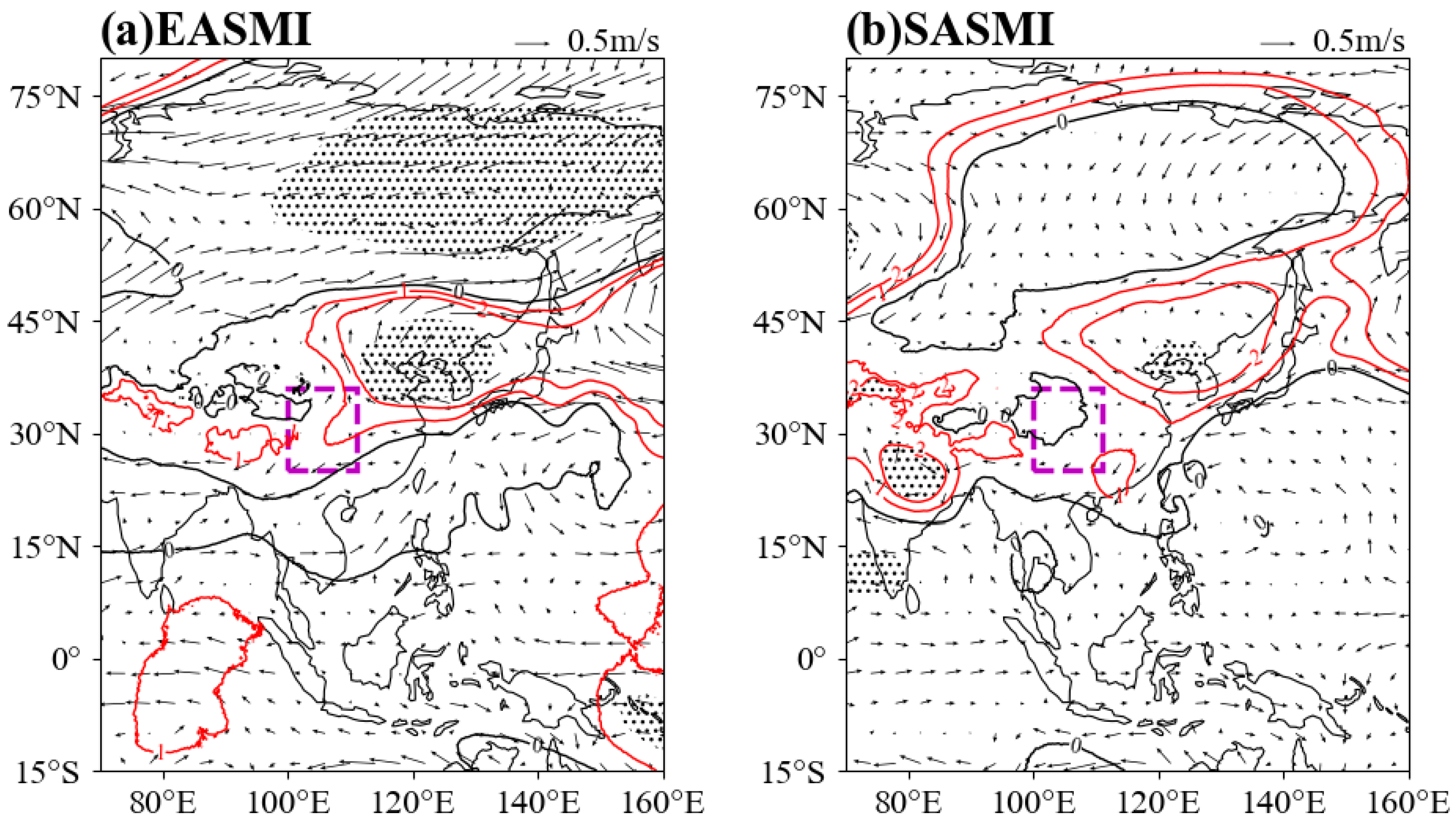
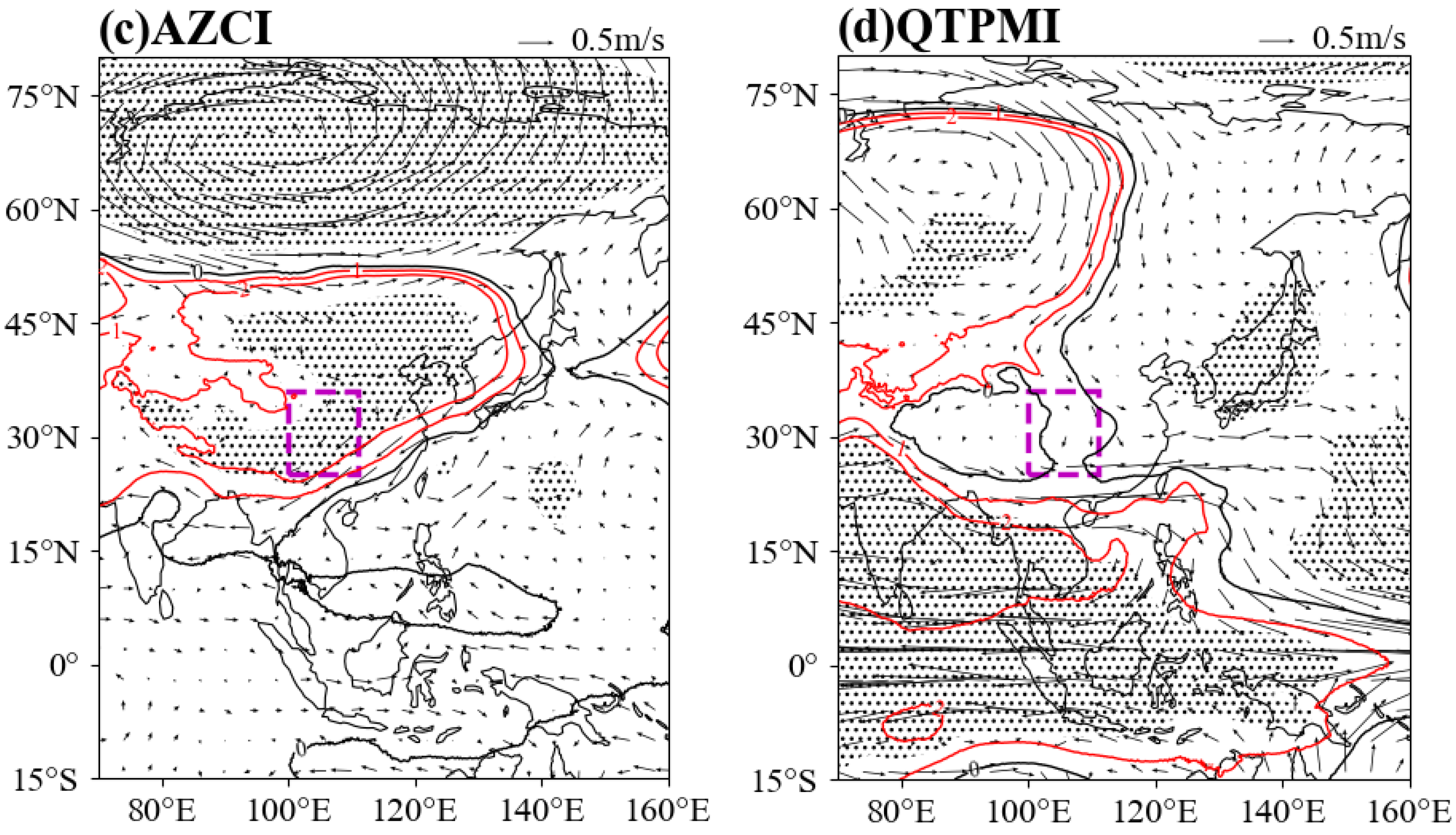
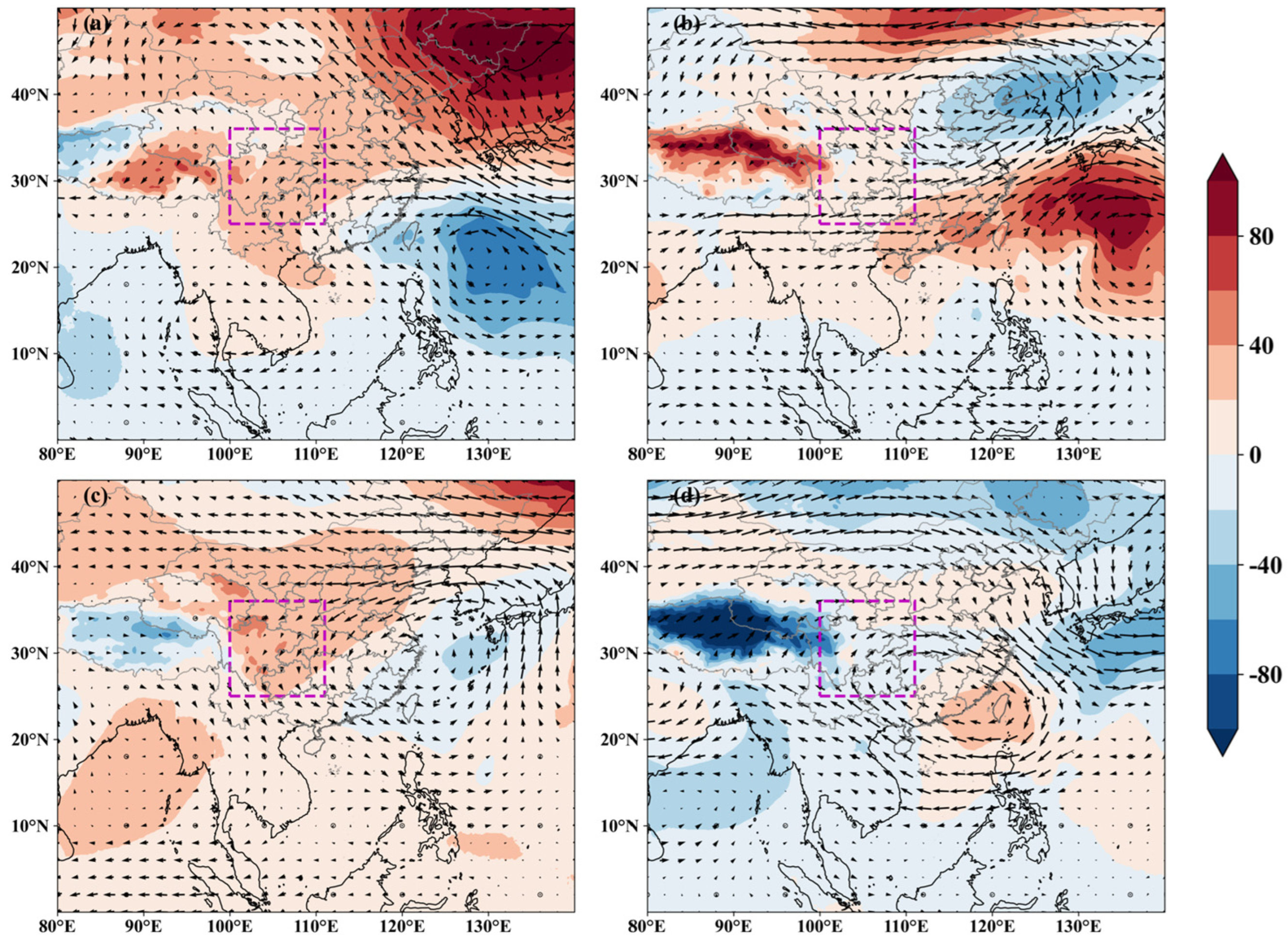

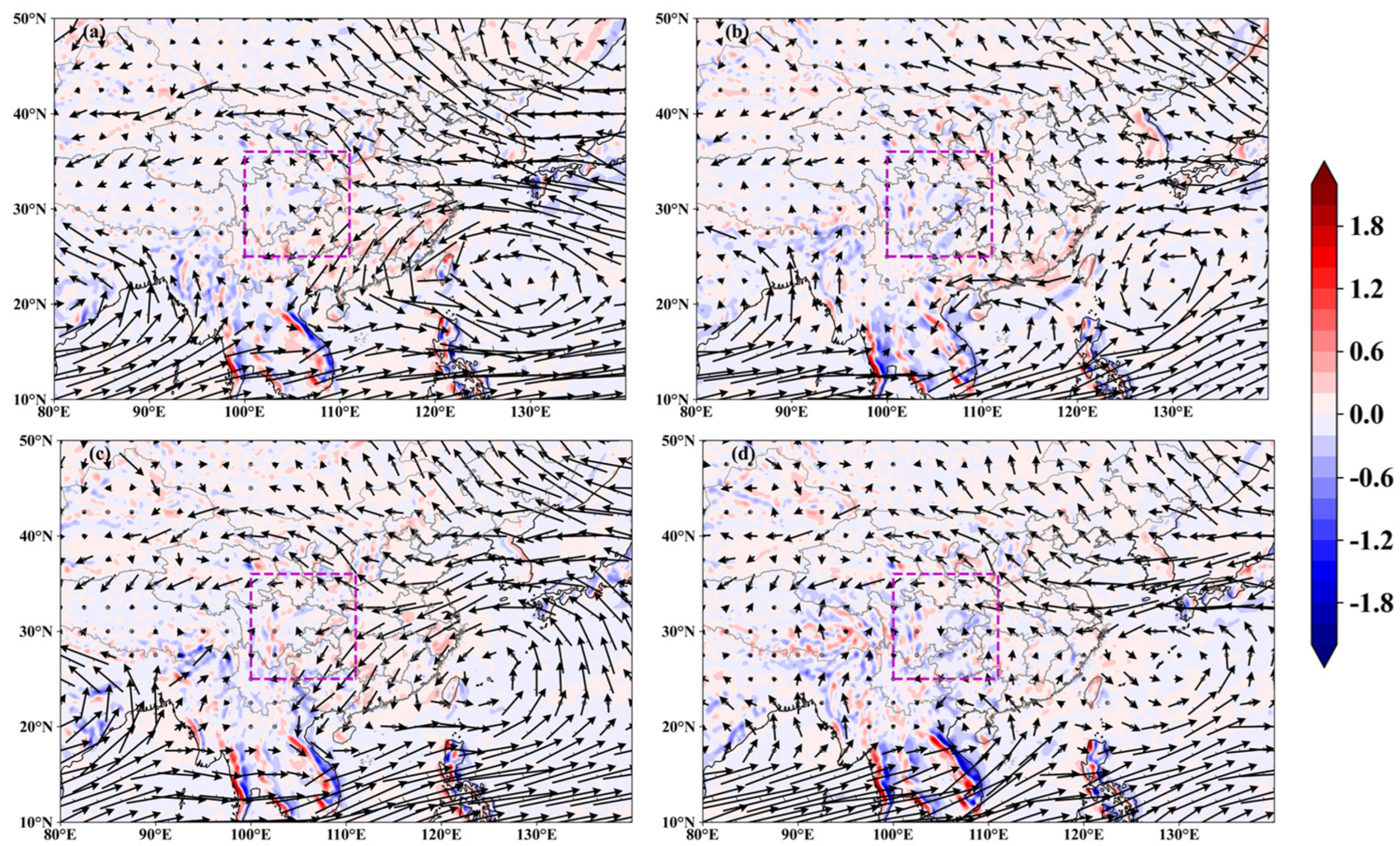
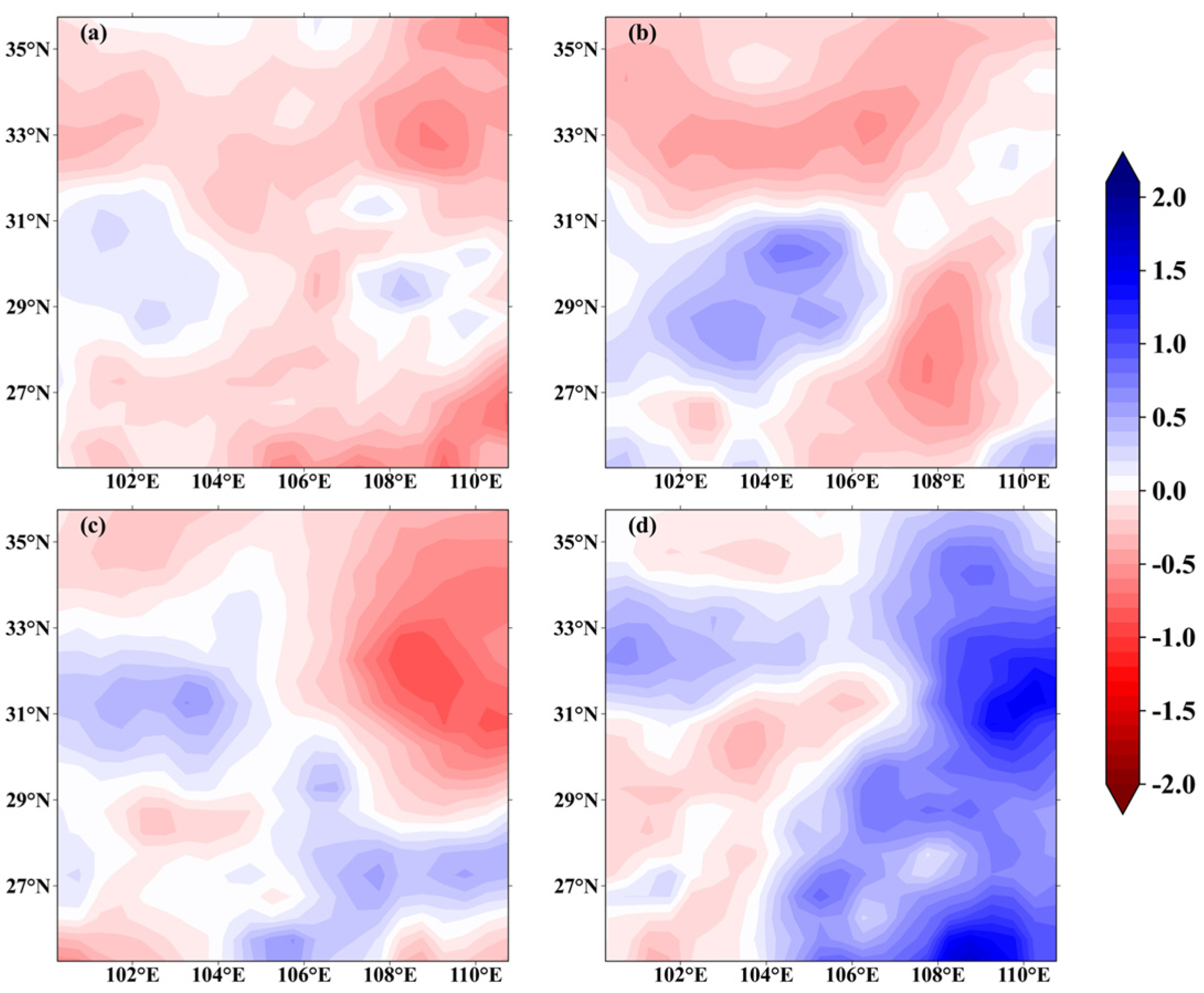
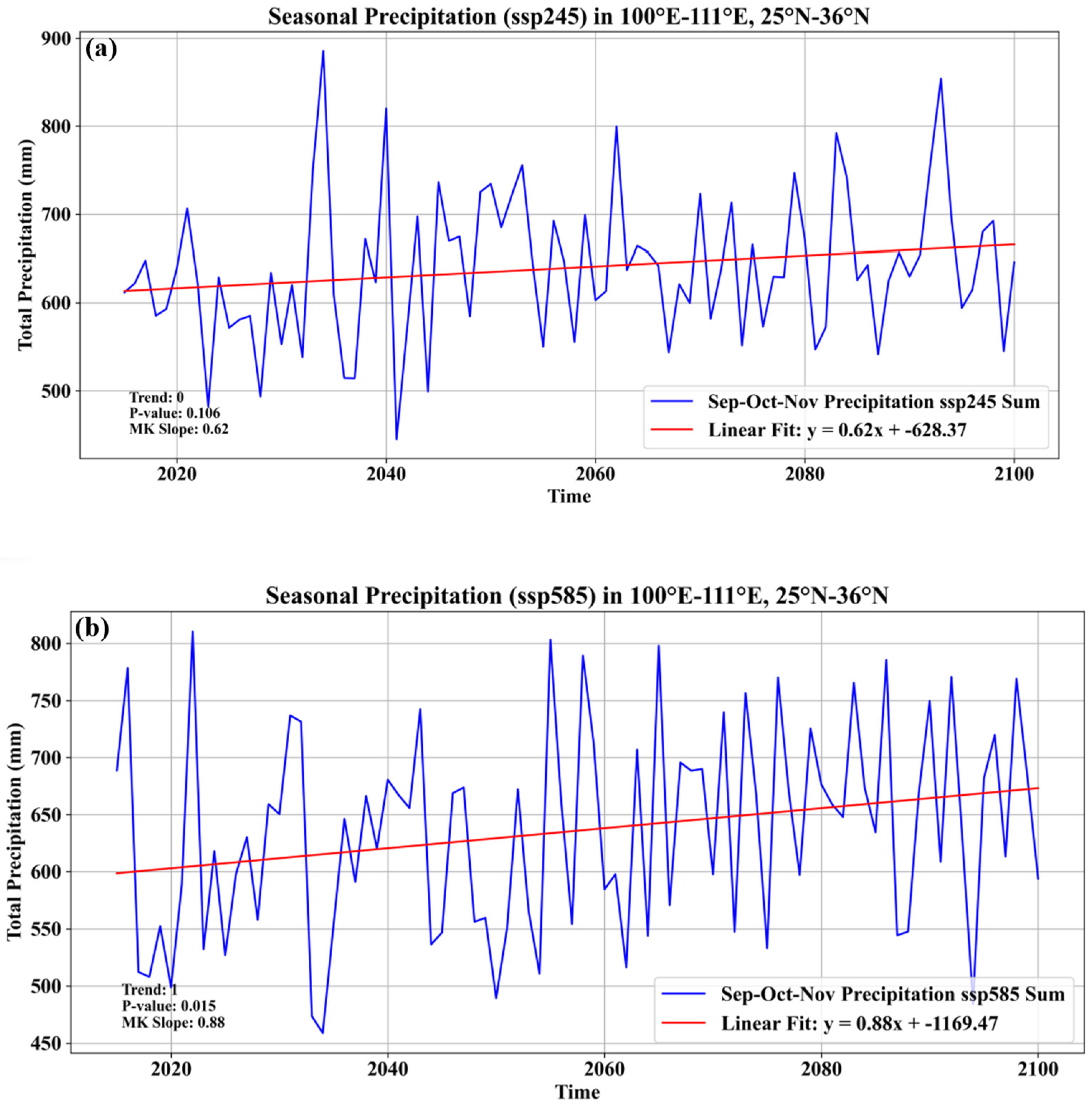
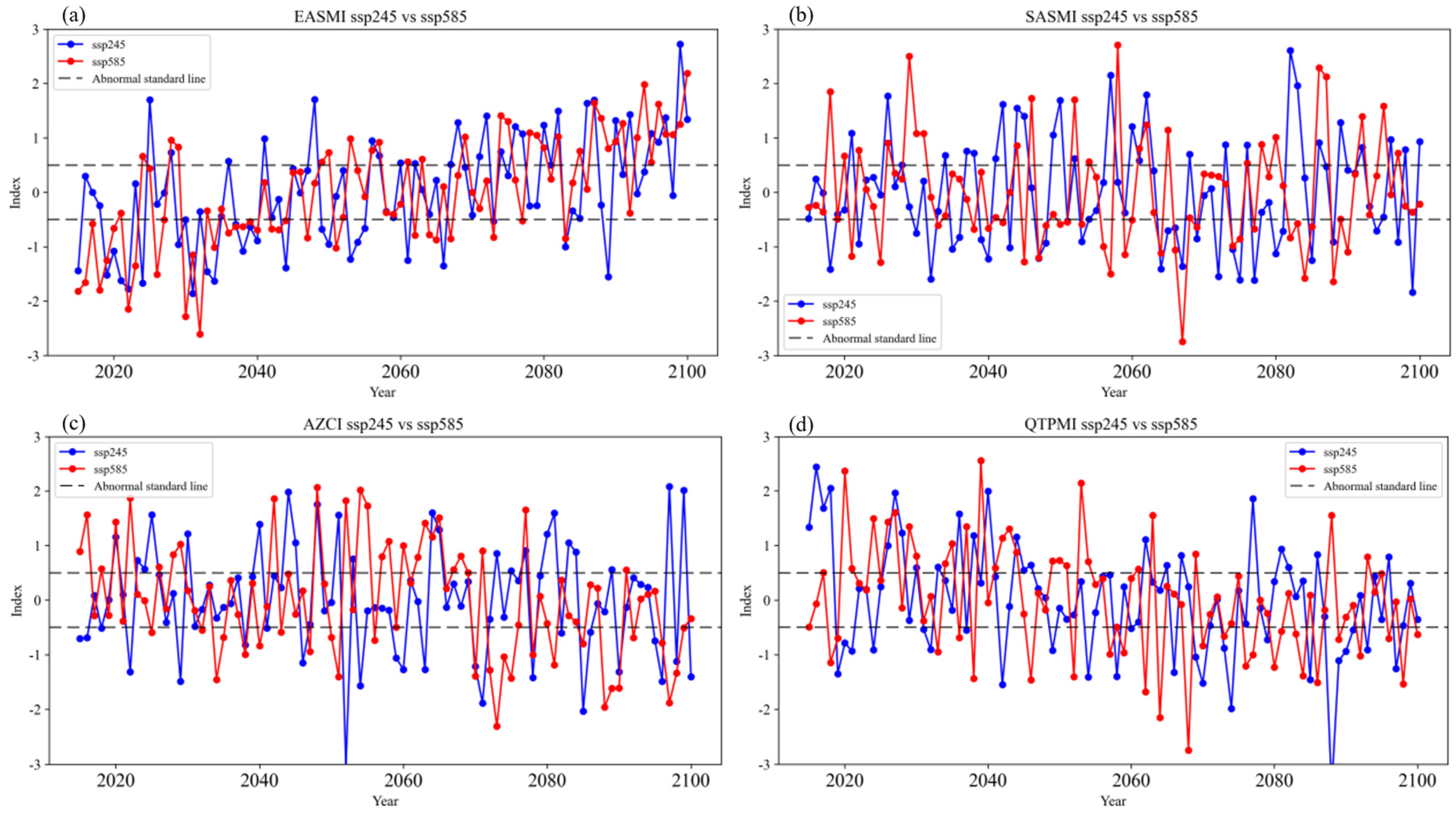
Disclaimer/Publisher’s Note: The statements, opinions and data contained in all publications are solely those of the individual author(s) and contributor(s) and not of MDPI and/or the editor(s). MDPI and/or the editor(s) disclaim responsibility for any injury to people or property resulting from any ideas, methods, instructions or products referred to in the content. |
© 2025 by the authors. Licensee MDPI, Basel, Switzerland. This article is an open access article distributed under the terms and conditions of the Creative Commons Attribution (CC BY) license (https://creativecommons.org/licenses/by/4.0/).
Share and Cite
Song, L.; Fan, L.; Lin, C.; Li, J.; Xu, J. Synergistic Effects of Multiple Monsoon Systems on Autumn Precipitation in West China. Atmosphere 2025, 16, 481. https://doi.org/10.3390/atmos16040481
Song L, Fan L, Lin C, Li J, Xu J. Synergistic Effects of Multiple Monsoon Systems on Autumn Precipitation in West China. Atmosphere. 2025; 16(4):481. https://doi.org/10.3390/atmos16040481
Chicago/Turabian StyleSong, Luchi, Lingli Fan, Chunqiao Lin, Jiahao Li, and Jianjun Xu. 2025. "Synergistic Effects of Multiple Monsoon Systems on Autumn Precipitation in West China" Atmosphere 16, no. 4: 481. https://doi.org/10.3390/atmos16040481
APA StyleSong, L., Fan, L., Lin, C., Li, J., & Xu, J. (2025). Synergistic Effects of Multiple Monsoon Systems on Autumn Precipitation in West China. Atmosphere, 16(4), 481. https://doi.org/10.3390/atmos16040481





